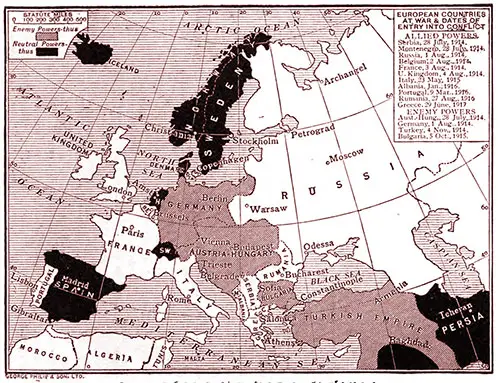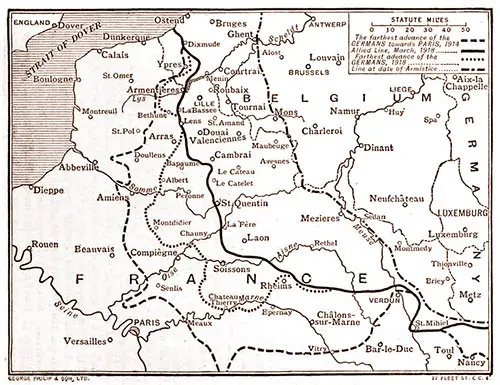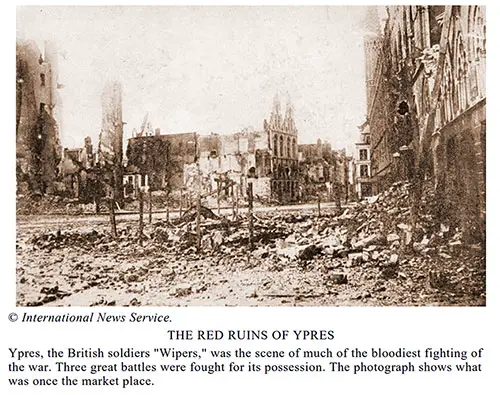Britain Joins the War - 4 August 1914

Map of European Countries Engaged in the Great War, An Advanced History of Great Britain, 1920. GGA Image ID # 17fc6e16a6
The only question still open was what Britain was to do. To prevent the war, Sir Edward Grey proposed to refer all disputes to a European conference; but the Central Powers contemptuously rejected his suggestion.
Germany persuaded herself that Britain was too conscious of her military weakness, too much wedded to the doctrine of peace at any price, and too fearful of civil war. Ireland to venture to draw the sword.
Yet she hated and feared Britain even more than her continental enemies, knowing that Britain's sea-power stood between her and the maritime and colonial expansion schemes that were dearer to Germany than even continental ascendancy.
In her eagerness to make the war short and decisive, she wants only provoked British hostility by demanding from Belgium a passage for her troops through Belgian territory so that she might strike at France on her unprotected northern frontier.
The neutrality of Belgium had been solemnly proclaimed by all the powers after her independence had first been established, and Britain was known to lay special stress upon its maintenance. But Britain was roughly told that treaties were but " scraps of paper" and that Germany was resolved to take the shortest road to victory.
This gross contempt for public law silenced the last hesitation on Britain's part. Impelled by interest and honor to support France and Russia from wanton attack, she was doubly bound to stand forth as the protector of a weak state like Belgium and vindicate international law's sanctity against the doctrine that might make right.
On August 4, she went to war against the Central Powers. Great levies of men and vast grants of money were made. Kitchener was appointed war minister; all the available forces, amounting to about 150,000 men, were sent over the Channel under Sir John French. Under Admiral Jellicoe, the navy was already prepared to convoy the expeditionary force and uphold British supremacy on the seas against the new German navy.
The Invasion of France, August 1914
The early course of the war went almost as the Germans had expected. The little Belgian army was overwhelmed, and a huge German force-marched through conquered Belgium into France.
By this time, British troops were joining with the French, but the northern army of the allies couldn't hold its own against the overwhelming numbers of the invaders.
Defeated at first between Mons and Charleroi, and later on the line between Cambrai and Le Cateau, the Anglo-French army was driven back into the heart of France. The Germans crossed the Maine and threatened Paris.

Map of the Operations on the Western Front, An Advanced History of Great Britain, 1920. GGA Image ID # 17fca2788c
The Battles of the Marne and of the Aisne
The French government fled to Bordeaux. A fresh army, assembled to defend Paris, held the line of the Ourcq, a northern tributary of the Marne. It thus stood on the right flank of the advancing Germans.
But the Germans, despising their enemies, pushed on southwards. Thereupon the French, with wise daring, fell fiercely on their flank.
Meanwhile, the beaten armies of France and England made a wonderful recovery. Between 6 and 10 Sept., Paris was saved by the battle of the Marne.
The Germans were beaten back from the Marne to the Aisne, where they dug themselves in so effectively that the allies were brought to a standstill.
After a fortnight of hard fighting, called the battle of the Aisne, the French and English also entrenched themselves opposite the Germans.
The Battle of Ypres, October-November 1914

The Red Ruins of Ypres. Ypres, the British Soldiers "Wipers, " Was the Scene of Much of the Bloodiest Fighting of the War. Three Great Battles Were Fought for Its Possession. the Photograph Shows What Was Once the Marketplace. Photograph © International News Service. History of the World War, 2006. GGA Image ID # 197b19856d
With rare insight, Kitchener foretold three years of war and set doggedly to work to create a British army that could play its fair share in defense of the freedom of Europe. The danger, however, though less immediate, was still imminent.
A desperate attempt to save Antwerp by a hastily levied British force failed lamentably, and all Belgium fell into the Germans' hands, save a little scrap of south-western Flanders, in the midst of which was the historic town of Ypres.
To preserve this fragment, the French's army was skillfully transferred from its first position on the Aisne to the northern sector, where it joined hands with what was left of the troops who had failed at Antwerp.
The Germans desperately tried to break through their thin lines in the first battle of Ypres between October 20 and November 11. But the British, though forced back, did not yield before the sevenfold odds brought against them. Thereupon both sides settled down to the monotony of winter trench warfare.
The Western Field of Battle, 1914-1917
The positions taken up by the rival armies in November 1914 remained substantially the same until the summer of 1918. The allied line ran from the North Sea near Nieuport, along the Yser, and bending just East of Ypres, crossed the Lys near Armentières and continued southwards, west of Lille, to the eastern suburbs of Arras, and thence by Albert on the Aniere, to the Somme.
A few miles to the south, it bent eastwards to the Oise and thence along the Aisne and the Vesle to Reims, whence the trenches stretched to Lorraine's borders, and then, bending southwards again, almost followed the frontier up to the Swiss border.
The Belgians held the trenches along the Yser; the British stretched from the Yser to near Arras. When her new levies were ready, they took over more of the line until, within two years, their posts extended to the Somme. The rest of the front was defended by the French.
The Period of Trench Warfare 1914-1917
Along the 400 miles between the sea and the Jura, constant engagements raged, involving the loss of myriads of lives but in no substantial way affecting the balance of fortune.
The allies held on, hoping that time would enable them to bring their full forces to the fight. Though not anticipating a war of positions, the Germans showed great skill in adapting themselves to its requirements. Their interest was still to quicken the pace.
By concentrating huge masses of troops on the enemy's line's weak places, they strove to force their way through. But none of these attempts had any real measure of success.
In the second battle of Ypres (22 April-13 May 1915), they narrowed down the British salient but could not capture Ypres, much less fight their way to Calais.
In the battle of Verdun (Feb.-April, 1916), they advanced almost to the walls of the hardly beset fortress city of the Meuse but were at last brought to a standstill and soon to yield ground before fierce French counter-attacks. The allies were not more fortunate in their attempts to beat back the Germans.
The French advances involved a huge sacrifice of life. The British attempts to break the lines that blocked the approach to Lille were almost as costly.
The unbounded hopes, excited by such local successes as Neuve Chapelle's capture (March 10, 1915), were soon shown to be vain.
The most important offensive which the British and French shared was that called the battle of the Somme, which began in July 1916 and continued for the rest of the year.
The winter-struggle which succeeded it called the battle of the Ancre (November 18 to March 11, 1917), carried the allies to the gates of Bapaume and Peronne. It was the first offensive that seriously contracted the enemy's line.
Yet, neither French nor British were ready for a great advance. The British were at a special disadvantage by reason of weak numbers, insufficient munitions, and sometimes bad staff-work as well. But the allies accomplished at least as much as their enemies.
T. F. Tout, M.A. F.B.A., "Britain Joins the War - 4 August 1914," in An Advanced History of Great Britain from the Earliest times to 1918, London: Longmans, Green and Co., 1920.
